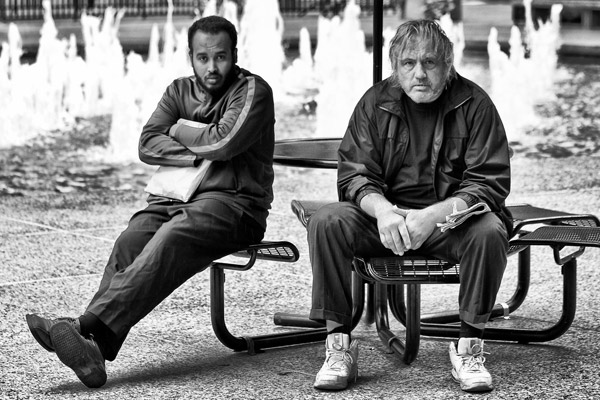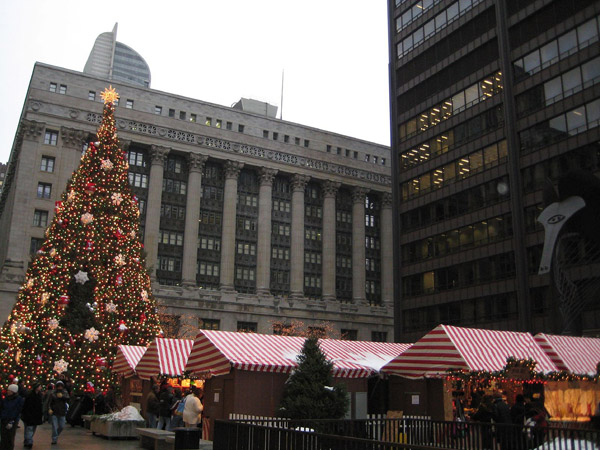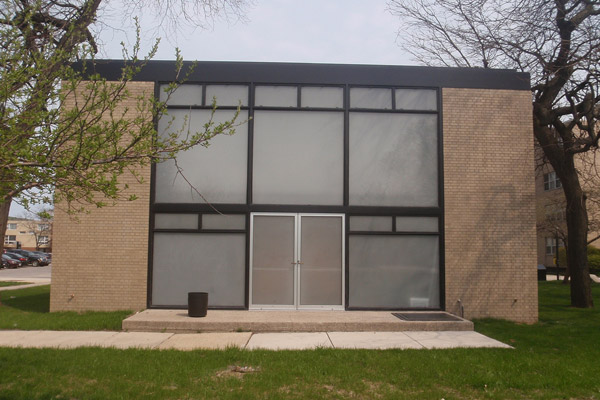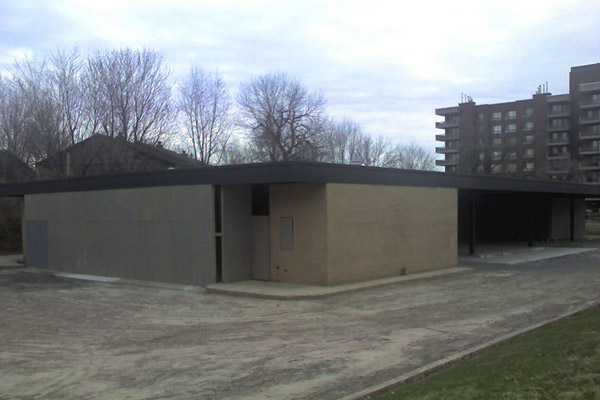It's Ludwig Mies van der Rohe's 126th birthday, and Google is celebrating with one of its vaunted Google Doodles. Of course, they have to profane his sacred legacy in order to get the company colors in:

Colors? Please. It looks more like Rem Koolhas to me.
This is, of course, one of the problems with Mies's legacy: his ideas as an architect and artist run counter to the ways in which the users of his buildings—residents, workers, passers-by—interact with them. One of the most famous examples is his Seagram Building in New York:
The more you study the Seagram Building, the more fitting it seems that Mies is famously linked to the phrase, “God is in the details.” (Incidentally, he’s often credited with coining the maxim, but his biographer never found anyone who heard him actually say it.) The Seagram Building is filled with details, right down to the meticulous design of the window blinds. See, Mies hated the way a building looked when its tenants drew their blinds in different directions. For his Manhattan masterpiece, he installed blinds that only worked in three positions: fully drawn, half drawn, and fully open. Sure enough, photographs of the Seagram Building tend to show off a classy kind of uniformity.
Classy, but like a lot of classy things, also uncomfortable, constricting, and arrogant.
The plaza of the Seagram building is the subject of an influential documentary/urbanist analysis flick, William H. Whyte's The Social Life of Small Urban Spaces (which, in order to watch, I had to lower my office window blinds about two-thirds of the way down). For the film, Whyte took time-lapse film of the plaza's use throughout the day, and it's interesting to watch: the Seagram Building plaza is quite popular, but only at the edges where the water and places to sit are. Whyte uses Seagram Plaza as a successful urban space, but no more than 101st Street in Harlem.
William H. Whyte: The Social Life of Small Urban Spaces – The Street Corner from MAS on Vimeo.
Daley Plaza functions in the same way (it's not a Mies building, but it's nearly identical to Seagram Plaza, built in the International style). Which is why one of my favorite days in Chicago is when the aesthetically inappropriate picnic tables get hauled out so that people can hang out there (photograph: mootown).

Or when the defiantly anti-Internationalist Christkindlemarket takes over (photograph: puroticorico)

In some ways, it's an excellent urban space: its immense size and lack of ornamentation makes it an excellent theater for public protest, that most democratic of activities. And the chaotic movement of the protests is heightened by their contrast to the blank looming power of the administration building, like the monolith from 2001… well, not come to life exactly, but stuffed with bureaucrats.
Which is the problem with Mies's buildings: people don't really like them. Tom Wolfe's populist broadside From Bauhaus to Our House was poorly received by architects and architectural critics, but it captured something like popular opinion, as the actual architectural critic Paul Goldberger noted in his review:
Modern architecture has never been as much liked as its creators pretended it was; they saw the austere and rather puritanical buildings of glass and steel that were being made for the first time in the 1920's as signposts of a new age, as the physical shelter for a new, utopian society. The most ardent among them saw modern architecture not only as the setting for this society, but as the very catalyst that would bring it into being, as the physical setting that would assure the good life for all.
Here in Chicago they don't seem particularly beloved, either. The Robie House is a more beloved landmark than the building that's arguably Mies's great Chicago residential masterpiece, 860-880 Lake Shore Drive. The Hancock Building is more identified with the city than IBM Plaza, perhaps because of its distinctive silhouette and familiar X-braces (which mirror the steel beams that hold up the El throughout much of the city).
"Austere and puritanical" sums up Mies's earliest influence, the gothic cathedrals he grew up among in Germany. And he passed that moral austerity on to his buildings, as Ross Miller (author of one of my favorite books about Chicago, Here's the Deal) captured in Robert Hughes's BBC documentary* on Mies when he discussed living in 860-880:
People are devoted to these places. In fact, some of them are in their 80s and 90s and still expect Mies to come in and say, "well, I don't like what you did with that, why did you move this or that, and why do you have this drape over here?" So they keep it absolutely severe in the way they imagine the architect coming, and his presence is still in these apartments… they really were laboratory mice in this great architectural experiment, and seemed to grow to love it.
So it's sort of like expecting your overbearing parents to come by and criticize your life choices, only if by "parents" you mean "126-year-old German expatriate known—even by the standards of German artists—for his moral severity." Sounds fun! Toss your bunny slippers, Mies is watching you.
I did also experience the dark side of Mies, which is the absolute severity, the austerity… you know, no-days-off sort of sense that you live seriously every second of your life. Here is an environment that is as good as you are on your best day. It's not a place to feel depressed, or wanting a nap. There's enormous freedom in this architecture, but sometimes you didn't feel up to it. Here was a man at the top of his game, putting you in this aesthetic environment, and giving it over to you, but never really giving you the car keys.
After Miller finishes, Hughes takes us to Mies's personal apartment (then-home of John Holabird and his wife). It looks like a freaking bed-and-breakfast. Janet Holabird tells Hughes that Mies liked its "old world atmosphere."
That's the funny thing about Mies. His buildings are sacred, not just because of his reputation, but because he brought a sacredness to the spaces he built: the combination of lightness and severity that defines church architecture, particularly Gothic church architecture. It's miraculous: designing an apartment building that its inhabitants treat with the gravity of a church, with Mies as its omniscient, judgemental Creator, is an extraordinary artistic achivement. (If I could be promised it would have a similiar effect on my drunken, degenerate neighbors, I'd commission one myself.)
But it's also a problematic one. When everything is sacred, from corporate law offices to city administrative buildings, nothing is sacred. "There is no reason that a cathedral should not be built to the same architectural standards as a garage," Mies said. And he proved his point: his sole sacred building, IIT's chapel—the "God box"—looks like a garage (photograph: PinkMoose).

As Hughes narrates in his tour of IIT, "the chapel at IIT had to have a sign on it that said 'chapel,' to distinguish it from the rest of the campus."
That's why my favorite Mies building, even though I've never seen it, is his gas station on Nun Island near Montreal. Yes, Mies built a gas station, and that fact fills me with joy. While his rigid, minimalist style adapted poorly to religious architecture, and stunningly if not entirely pleasantly to residential buildings, it makes for a perfect gas station. The long, narrow lines, the immense central space transparent from front to back, the minimal structural support: knock the windows out of any given Mies building, stick some pumps in, and fill 'er up (photograph: Wikipedia).

It's in the midst of restoration—and when completed, it will be a multiuse youth and senior center serving purposes not unlike, and looking very much like, Crown Hall. There you have the legacy of Mies: everything from church to corporation to educational institution to gas station treated with a sensibility approaching awe. (It's no wonder that the Cult of Apple, which is very much a design cult, is frequently associated with Mies.) It's an admirably rigorous philosophy, but also one that can be unsettling, especially when it places a house of worship on the same architectural plane as a gas-'n'-go. That's ultimately why I think the hoi polloi, like me, are unnerved by the buildings he left behind.
Perhaps the one exception is Lafayette Park in Detroit, which is instructive:
With their aluminum-and-glass skins, and interiors that open to the outdoors, the townhouses themselves are reminiscent of the elegant buildings on the campus of Mies's Illinois Institute of Technology on the South Side of Chicago. But IIT has little lush landscaping, so the effect is austere and far from lovely.
[snip]
One well might ask whether Lafayette Park, rather than Mies's more celebrated developments, is in fact what the Modernists really intended. Indeed, Mr. Garvin remembers once lamenting that the Modernists had never actually implemented their City of Tomorrow — their ideal of dense but serene housing in a garden setting. Then he saw Lafayette Park and concluded that he had found the real thing — a project that faithfully carried out Modernist principles of simplicity, light and air, while providing housing so desirable it survived even as whole sections of Detroit burned.
Of course human beings have modified Lafayette Park over the years, most notably in the landscaping, which reflects the current owners' preference for flowers over shrubs.
In full bloom, Lafayette Park is vibrant, both inside and outside. The owners' preference for flowers passed through to the interiors. It's clear that the residents don't approach with the same supplication as those of Mies's Lake Shore Drive building.
When Rem Koolhas took on the monumental task of bringing some vim to the legendary canvas that is IIT, he faced inevitable criticism for his wild design choices, which included turning the icon of architecture into an icon. He wrote in response:
Trouble. According to statistics, a student and his or her parents decide, within five seconds of arrival, whether to apply to a given university or not.
With that test, Mies van der Rohe’s IIT Campus is in trouble.
The IIT campus is a masterpiece invisible to the contemporary eye. Mies’ work has become unnoticeable without explanation.
Cleaning
I do not respect Mies, I love Mies.
I have studied Mies, excavated Mies, reassembled Mies. I have even cleaned Mies.
Because I do not revere Mies, I’m at odds with his admirers.
Urbanism
It is a mistake to read Mies as a master of the freestanding, or the autonomous. Mies without context is like a fish out of water.
The iconography of Le Corbusier could dispense with neighbors or even the city; Mies would be unimaginable without them. In his collages and models, context is annexed to support his campaigns.
That's the hidden meaning in today's little Google Doodle. Mies created sacred spaces, but they require iconoclasm to appreciate.
* Below are the relevant bits of Robert Hughes's excellent Mies documentary, one of three he did on significant 20th century architects for the BBC. You can watch the whole thing here. You can also see which of Mises's pieces made our Top 40 buildings here.


